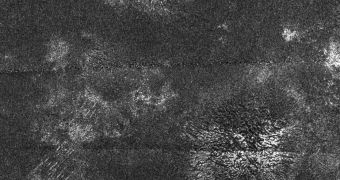As it orbits around Saturn, the NASA/ESA mission Cassini is continuously snapping new pictures of the gas giant and its moons, providing experts with new data at every new transmission. In a set of images of the planet's largest moon, Titan, snapped on December 28, 2009, researchers managing the science data from the mission discovered new, never-before-seen features at northern latitudes on the moon. Hills with wrinkly radial patterns were identified for the first time, and experts are currently working hard on analyzing them, experts at the NASA Jet Propulsion Laboratory (JPL), in Pasadena, California, say.
In the photos released to the press, grooved mounds are clearly visible in the region designated as Belet, in the northern hemisphere of Titan. According to the data extrapolated from the observations, it would appear that the landscape features are about 80 kilometers, or 50 miles, wide and have a height of roughly 60 meters, or 200 feet. Though they are new to the Saturnine moon, in the sense that they have never been discovered before here, the hills bear a remarkable resemblance to spider-like features known as coronae that were observed on Venus.
On the inner planet, these features are thought to be produced by the flow of heat in the Venusian interior. They are circular to elliptical features, and it's safe to say that no one at JPL expected to find them on Titan. On the other hand, the moon is known for its surprises, and for its bizarre surface, which includes permanent and seasonal lakes of liquid hydrocarbons, at locations around both poles. At this point, scientists operating the laser systems on Cassini are trying to work out how precisely these mounds and their lines were formed.
“This star-shaped pattern of the hills indicates something significant happening in the middle of the star. It might be caused by tectonic forces, such as the forces that pull the crust of a planet apart, or rainfall that leads to erosion, or an ice intrusion like a dike,” JPL Cassini radar team scientist Steve Wall explains. These forces are well known from our planet, where they produce similar effects, but planetary scientists warn that it's still premature to suppose that the same thing happens on Titan as well. Future Cassini flybys of the moon will focus on these areas as well, in an attempt to gather more data on them.

 14 DAY TRIAL //
14 DAY TRIAL //